Gate-Opening Criterion for Generating Dam-Break Flow in Non-Rectangular Wet Bed Channels
Abstract
:1. Introduction
2. New Criterion for the Gate Motion
3. Numerical Model
3.1. Governing Equations
3.2. Turbulence Modeling
3.3. Computational Domain, Boundary, and Initial Conditions
3.4. General Moving Objects
3.5. Sensitivity of Grid Size
4. Results
4.1. Model Validation
4.2. Water Depth at Fixed Position
4.3. Influence of the Gate Motion
4.4. Wave Front Velocity
5. Discussion
6. Conclusions
- (1)
- In the triangular channel, the dam-break simulated by removing a gate with the proposed criterion time (i.e., Equation (2)) approximates the instantaneous dam-break better than the Lauber–Hager criterion time. In particular, the Lauber–Hager criterion is invalid for generating the dam-break flow in wet-bed channels. The gate-opening time adopted in the laboratory facility should be determined based on the channel cross-sectional shape and the downstream/upstream water depth ratio.
- (2)
- At the initial stage of dam-break, the wave front velocity under the influence of the gate is much smaller than that of the instantaneous dam-break. This means that the gate has a great blocking effect on the dam-break flood. For the same condition, the opening time of the triangular channel is significantly affected by the gate compared with the rectangular channel. In non-rectangular channels, even if the gate is opened quickly, the influence of the gate cannot be ignored.
- (3)
- The gate motion leads to the variation of RRSME, representing the difference between the water depths related to the instantaneous dam failure and the dam-break generated by lifting a gate. The RRSME increases with the increase of the gate-opening time and decreases with the increase of the distance from the gate. This is particularly pronounced near the gate.
- (4)
- The Lauber–Hager criterion provides a conservative estimation of the gate opening time in the rectangular dry bed.
Author Contributions
Funding
Acknowledgments
Conflicts of Interest
References
- Bosa, S.; Petti, M. A numerical model of the wave that overtopped the Vajont dam in 1963. Water Resour. Manag. 2013, 27, 1763–1779. [Google Scholar] [CrossRef]
- Wang, B.; Zhang, T.; Zhou, Q.; Wu, C.; Chen, Y.L.; Wu, P. A case study of the Tangjiashan landslide dam-break. J. Hydrodyn. 2015, 27, 223–233. [Google Scholar] [CrossRef]
- Wang, B.; Chen, Y.L.; Wu, C.; Dong, J.H.; Ma, X.; Song, J.J. A semi-analytical approach for predicting peak discharge of floods caused by embankment dam failures. Hydrol. Process. 2016. [Google Scholar] [CrossRef]
- Wang, B.; Chen, Y.L.; Wu, C.; Peng, Y.; Song, J.J.; Liu, W.J.; Liu, X. Empirical and semi-analytical models for predicting peak outflows caused by embankment dam failures. J. Hydrol. 2018, 562, 692–702. [Google Scholar] [CrossRef]
- Alcrudo, F.; Mulet, J. Description of the Tous Dam break case study (Spain). J. Hydraul. Res. 2007, 45 (Suppl. 1), 45–57. [Google Scholar] [CrossRef]
- Kocaman, S.; Ozmen-Cagatay, H. Investigation of dam-break induced shock waves impact on a vertical wall. J. Hydrol. 2015, 525, 1–12. [Google Scholar] [CrossRef]
- Wang, B.; Chen, Y.L.; Wu, C.; Peng, Y.; Ma, X.; Song, J.J. Analytical solution of dam-break flood wave propagation in a dry sloped channel with an irregular-shaped cross-section. J. Hydro-Environ. Res. 2017, 14, 93–104. [Google Scholar] [CrossRef]
- Wang, B.; Chen, Y.L.; Peng, Y.; Guo, Y.K.; Zhang, J.M.; Song, J.J.; Liu, W.J. Approximate solution of shallow water equations for ideal dam-break flood along a wet bed slope. J. Hydraul. Eng. 2020, 146, 06019020. [Google Scholar] [CrossRef] [Green Version]
- Wang, B.; Liu, W.J.; Wang, W.; Zhang, J.M.; Chen, Y.L.; Peng, Y.; Liu, X.; Yang, S. Experimental and numerical investigations of similarity for dam-break flows on wet bed. J. Hydrol. 2020, 124598. [Google Scholar] [CrossRef]
- Wang, B.; Liu, W.J.; Zhang, J.M.; Chen, Y.L.; Wu, C.; Peng, Y.; Wu, Z.Y.; Liu, X.; Yang, S. Enhancement of semi-theoretical models for predicting peak discharges in breached embankment dams. Environ Fluid Mech. 2020, 20, 885–904. [Google Scholar] [CrossRef]
- Zanuttigh, B.; Lamberti, A. Dam-break waves in power-law channel section. J. Hydraul. Eng. 2001, 127, 322–326. [Google Scholar] [CrossRef]
- Wang, B.; Zhang, J.M.; Chen, Y.; Peng, Y.; Liu, X.; Liu, W.J. Comparison of measured dam-break flood waves in triangular and rectangular channels. J. Hydrol. 2019, 575, 690–703. [Google Scholar] [CrossRef]
- Lauber, G.; Hager, W.H. Experiments to dambreak wave: Horizontal channel. J. Hydraul. Res. 1998, 36, 291–307. [Google Scholar] [CrossRef]
- Aleixo, R.; Soares-Frazão, S.; Zech, Y. Velocity-field measurements in a dam-break flow using a PTV Voronoï imaging technique. Exp. Fluids 2011, 50, 1633–1649. [Google Scholar] [CrossRef]
- Hu, K.C.; Hsiao, S.C.; Hwung, H.H.; Wu, T.R. Three-dimensional numerical modeling of the interaction of dam-break waves and porous media. Adv. Water Res. 2012, 47, 14–30. [Google Scholar] [CrossRef]
- Ozmen-Cagatay, H.; Kocaman, S.; Guzel, H. Investigation of dam-break flood waves in a dry channel with a hump. J. Hydro-Environ. Res. 2014, 8, 304–315. [Google Scholar] [CrossRef]
- Ye, Z.; Zhao, X.; Deng, Z. Numerical investigation of the gate motion effect on a dam break flow. J. Mar. Sci. Technol. 2016, 21, 579–591. [Google Scholar] [CrossRef]
- Stolle, J.; Goseberg, N.; Nistor, I.; Petriu, E. Probabilistic investigation and risk assessment of debris transport in extreme hydrodynamic conditions. J. Waterw. Port Coast. Ocean Eng. 2017, 144, 04017039. [Google Scholar] [CrossRef]
- Lu, S.; Liu, H.; Deng, X. An experimental study of the run-up process of breaking bores generated by dam-break under dry-and wet-bed conditions. J. Earthq. Tsunami 2018, 12, 1840005. [Google Scholar] [CrossRef]
- Kamra, M.M.; Al Salami, J.; Sueyoshi, M.; Hu, C. Experimental study of the interaction of dambreak with a vertical cylinder. J. Fluids Struct. 2019, 86, 185–199. [Google Scholar] [CrossRef]
- Von Häfen, H.; Goseberg, N.; Stolle, J.; Nistor, I. Gate-opening criteria for generating dam-break waves. J. Hydraul. Eng. 2019, 145, 04019002. [Google Scholar] [CrossRef]
- Wang, B.; Liu, X.; Zhang, J.M.; Guo, Y.; Chen, Y.L.; Peng, Y.; Liu, W.J.; Yang, S.; Zhang, F.J. Analytical and Experimental Investigations of Dam-Break Flows in Triangular Channels with Wet-Bed Conditions. J. Hydraul. Eng. 2020, 146, 4020070. [Google Scholar] [CrossRef]
- FLOW-3D v11.2 Users Manual; Flow Science, Inc.: Santa Fe, NM, USA, 2017.
- Bradford, S.F. Numerical simulation of surf zone dynamics. J. Waterw. Port Coast. Ocean Eng. 2000, 126, 1–13. [Google Scholar] [CrossRef]
- Ran, D.; Wang, W.; Hu, X. Three-dimensional numerical simulation of flow in trapezoidal cutthroat flumes based on FLOW-3D. Front. Agric. Sci. Eng. 2018, 5, 168–176. [Google Scholar] [CrossRef] [Green Version]
- Oertel, M.; Bung, D.B. Initial stage of two-dimensional dam-break waves: Laboratory versus VOF. J. Hydraul. Res. 2012, 50, 89–97. [Google Scholar] [CrossRef]
- Yang, S.; Yang, W.; Qin, S.; Li, Q.; Yang, B. Numerical study on characteristics of dam-break wave. Ocean Eng. 2018, 159, 358–371. [Google Scholar] [CrossRef]
- Özgökmen, T.M.; Iliescu, T.; Fischer, P.F.; Srinivasan, A.; Duan, J. Large eddy simulation of stratified mixing in two-dimensional dam-break problem in a rectangular enclosed domain. Ocean Model. 2007, 16, 106–140. [Google Scholar] [CrossRef]
- Biscarini, C.; Francesco, S.D.; Manciola, P. CFD modelling approach for dam break flow studies. Hydrol. Earth Syst. Sci. 2010, 14, 705–718. [Google Scholar] [CrossRef] [Green Version]
- LaRocque, L.A.; Imran, J.; Chaudhry, M.H. Experimental and numerical investigations of two-dimensional dam-break flows. J. Hydraul. Eng. 2012, 139, 569–579. [Google Scholar] [CrossRef]
- Smagorinsky, J. General circulation experiments with the primitive equations: I. The basic experiment. Mon. Weather Rev. 1963, 91, 99–164. [Google Scholar] [CrossRef]
- Khoshkonesh, A.; Nsom, B.; Gohari, S.; Banejad, H. A comprehensive study on dam-break flow over dry and wet beds. Ocean Eng. 2019, 188, 106279. [Google Scholar] [CrossRef]
- Hirt, C.W.; Nichols, B.D. Volume of fluid (VOF) method for the dynamics of free boundaries. J. Comput. Phys. 1981, 39, 201–225. [Google Scholar] [CrossRef]
- Wei, G. A fixed-mesh method for general moving objects. Flow Sci. Tech. Note 2005. [Google Scholar] [CrossRef] [Green Version]
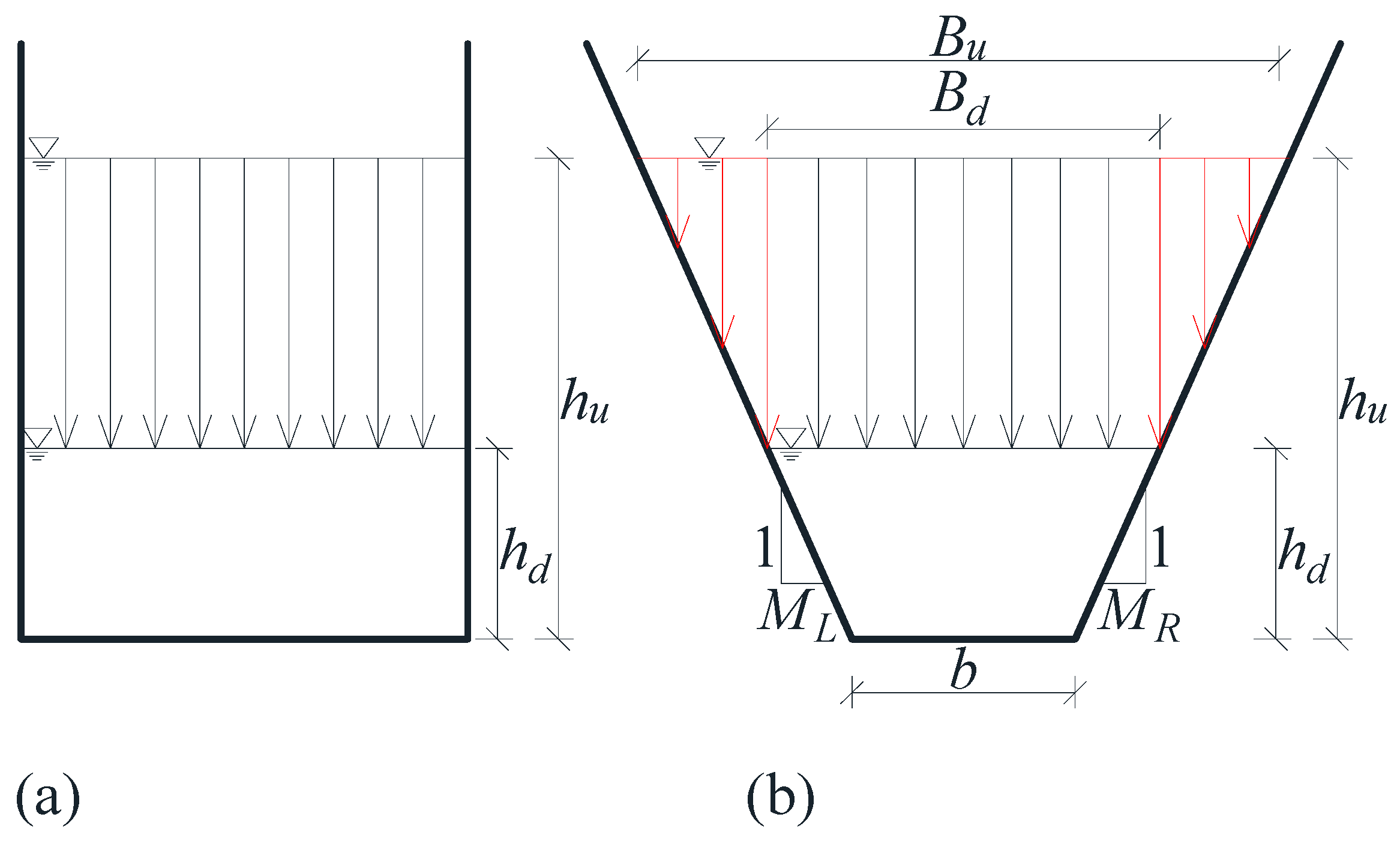


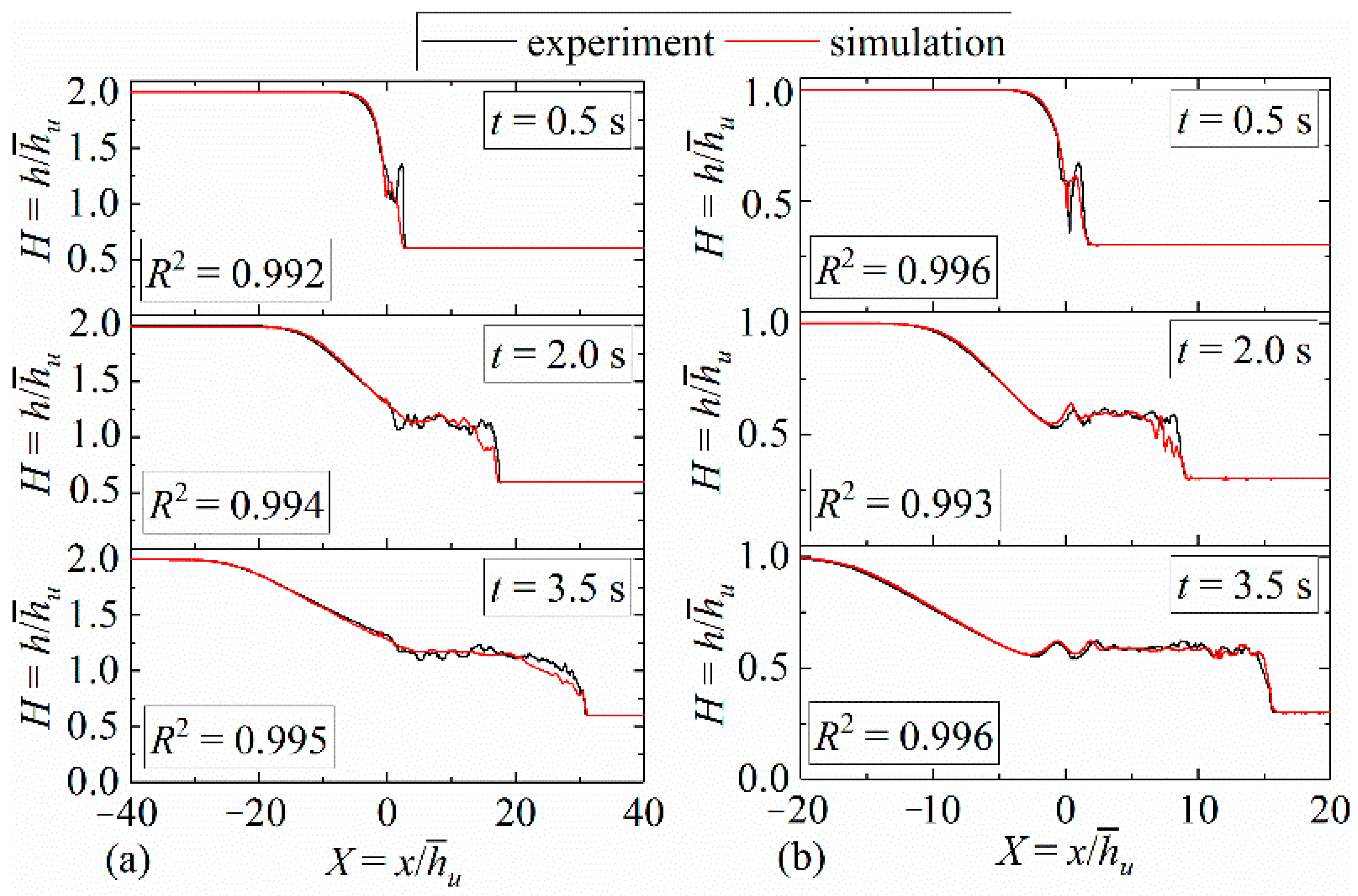
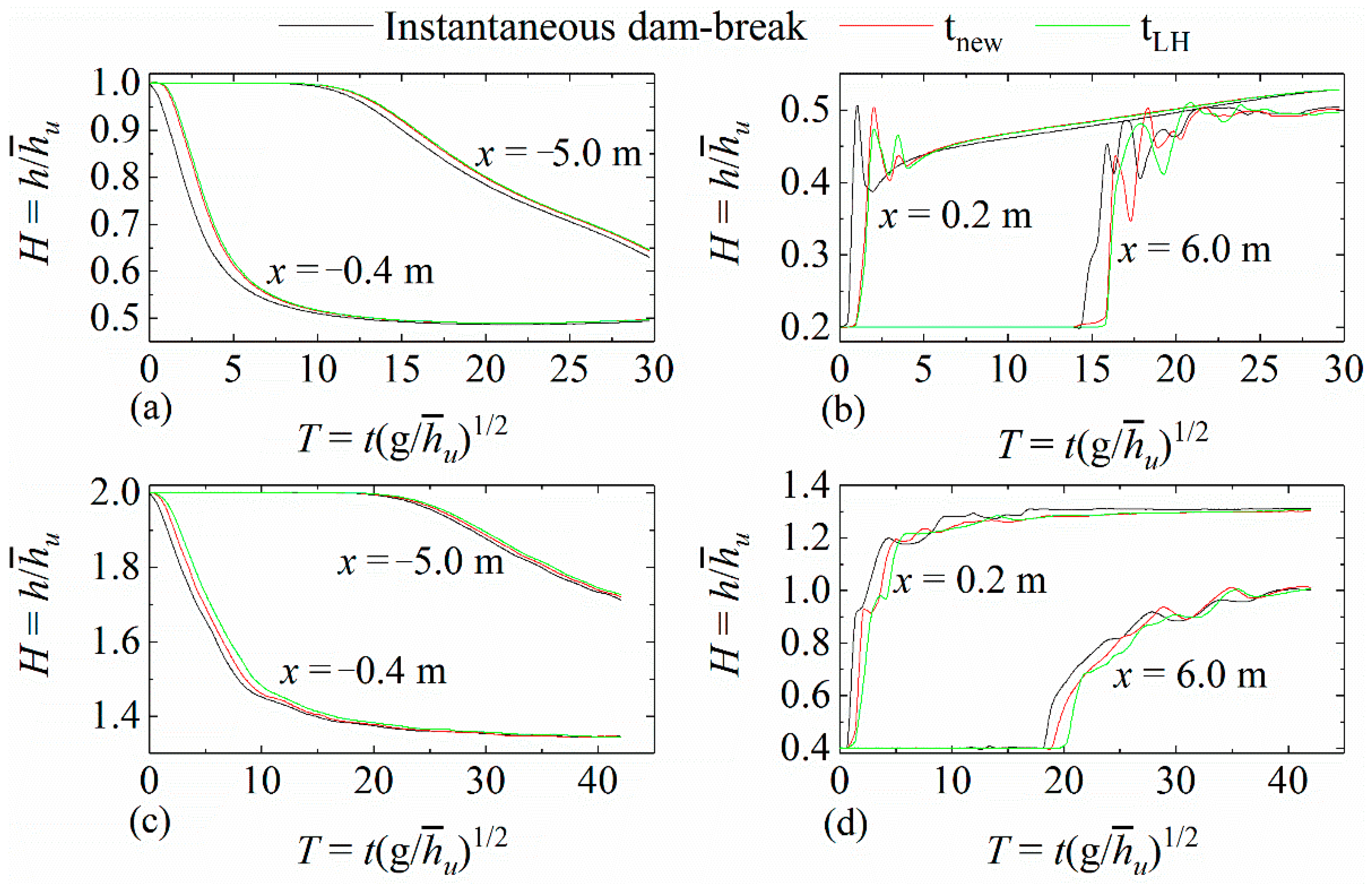
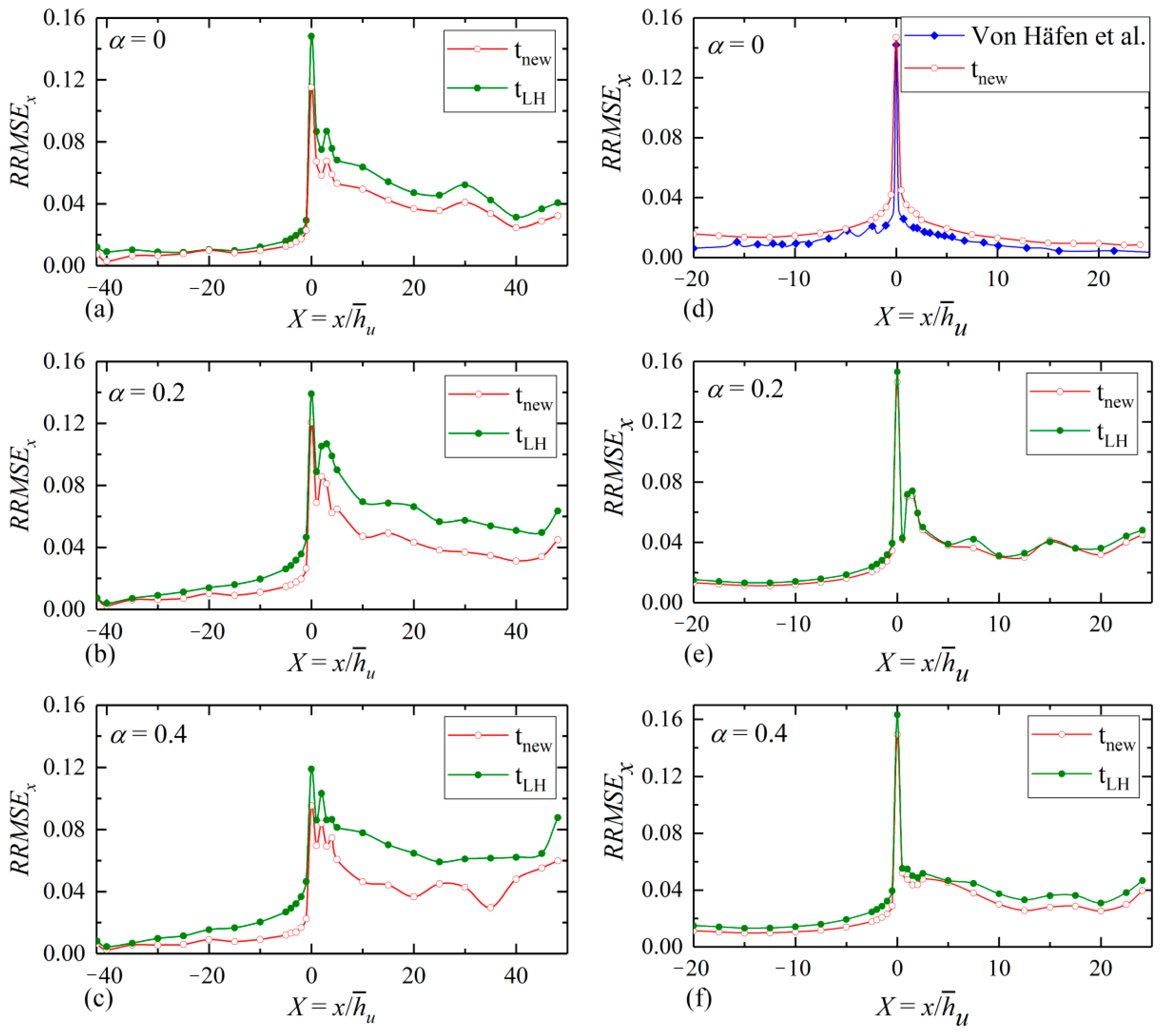
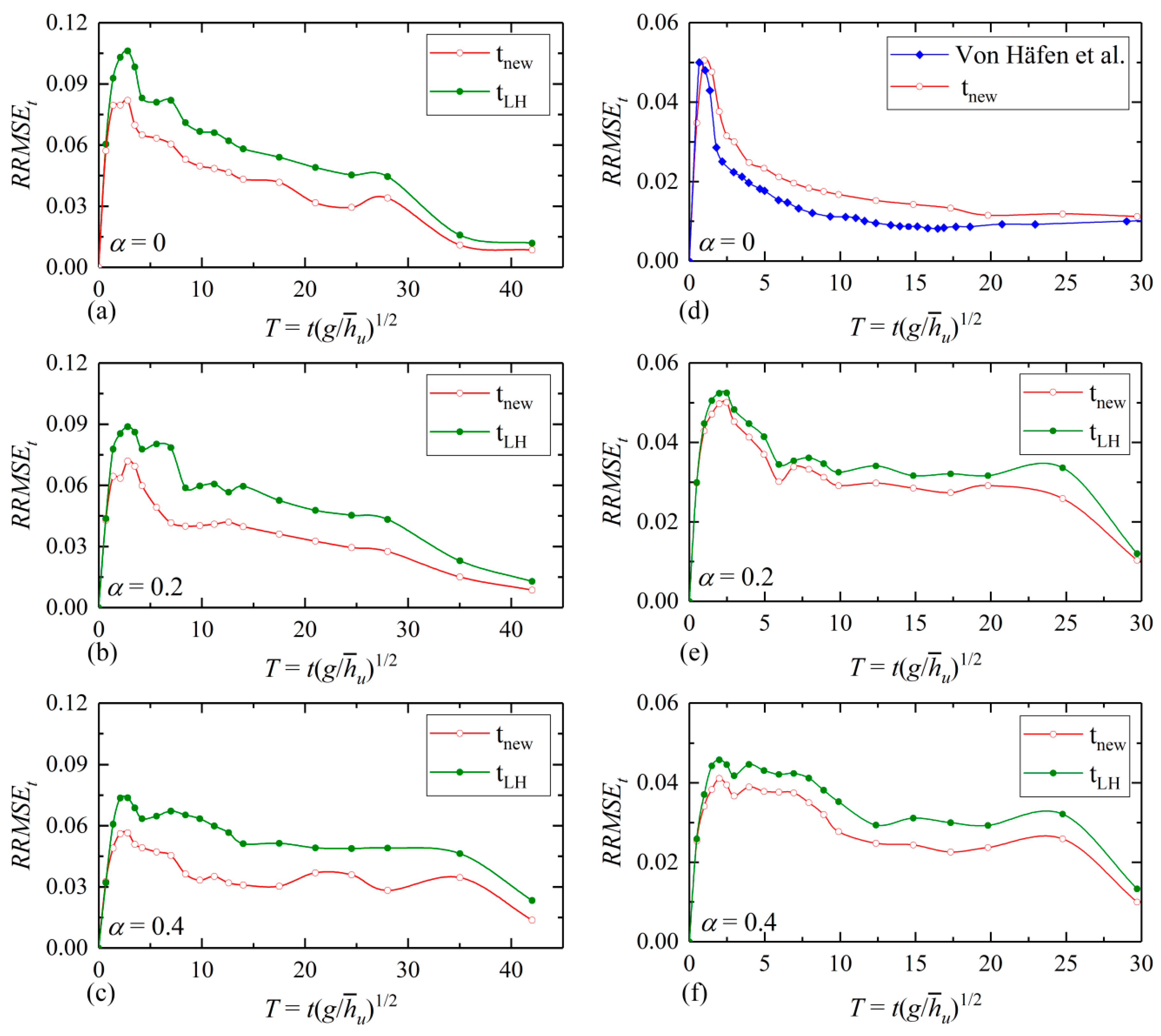
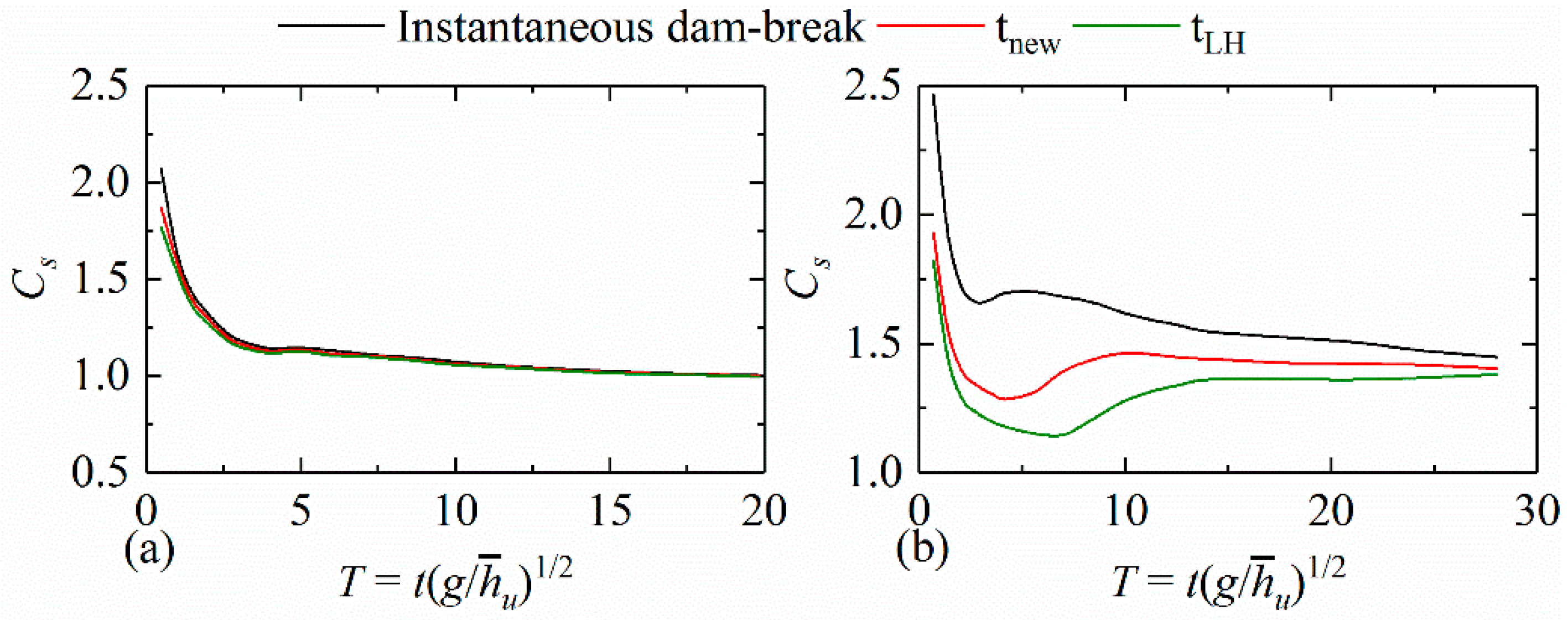
| Cross-Section | Blocks’ Domain (m) [x; y; z] | xmin | xmax | ymin | ymax | zmin | zmax |
|---|---|---|---|---|---|---|---|
| Rectangle | [−8.37~9.63; 0~1; 0~0.5] | No-slip | Outflow | No-slip | No-slip | No-slip | Symmetry |
| Triangle | [−8.37~9.63; 0~1; 0~0.5] | No-slip | Outflow | No-slip | No-slip | No-slip | Symmetry |
Publisher’s Note: MDPI stays neutral with regard to jurisdictional claims in published maps and institutional affiliations. |
© 2020 by the authors. Licensee MDPI, Basel, Switzerland. This article is an open access article distributed under the terms and conditions of the Creative Commons Attribution (CC BY) license (http://creativecommons.org/licenses/by/4.0/).
Share and Cite
Yang, S.; Wang, B.; Guo, Y.; Zhang, J.; Chen, Y. Gate-Opening Criterion for Generating Dam-Break Flow in Non-Rectangular Wet Bed Channels. Energies 2020, 13, 6280. https://doi.org/10.3390/en13236280
Yang S, Wang B, Guo Y, Zhang J, Chen Y. Gate-Opening Criterion for Generating Dam-Break Flow in Non-Rectangular Wet Bed Channels. Energies. 2020; 13(23):6280. https://doi.org/10.3390/en13236280
Chicago/Turabian StyleYang, Sha, Bo Wang, Yakun Guo, Jianmin Zhang, and Yunliang Chen. 2020. "Gate-Opening Criterion for Generating Dam-Break Flow in Non-Rectangular Wet Bed Channels" Energies 13, no. 23: 6280. https://doi.org/10.3390/en13236280






